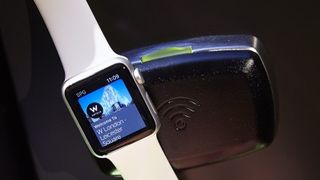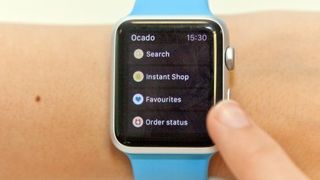This is what it's like developing an Apple Watch app
Limited access to the hardware and a whole new set of challenges
Again, the fleeting nature of how consumers interact with this device is key. If it lasts longer than a glance (or 'Glance', as it turned out), it's out.
At a glance guide
And as the screens get smaller, interactions become shorter but, interestingly, more frequent. "Although our web and smart phone app share a lot of the same functionality," says Ocado's Weekes, "they don't share the same interactions. We needed to make sure the apps worked for specific devices, screens and browsers. On our website customers will spend around 30 to 40 minutes doing their grocery shopping, whereas our smartphone apps customer spends a shorter amount of time, but visit more frequently."
"When it came to build our Watch app, our approach was completely different. We quickly understood that the user interactions would be quicker and probably even more frequent. And we wanted to push the boundaries even further. What if you could complete your weekly grocery shop in less than 15 seconds with just two taps? Well now you can and our customers are using it."
The small screen real estate again was a real tester for Starwood. The hotel group was the first company to introduce keyless entry via the Watch, bagging a money-can't-buy spot on Apple's second international Watch presentation.

"It's less about shrinking the experience that you have on your phone and putting it on the Apple Watch and more thinking about what information is relevant," explains Daniel Kerzner, Vice President Digital, Loyalty and Partnership Marketing at Starwood Hotels. "So it's perhaps less information, but it's more relevant to a guest at a specific time. So it's the address of the hotel, for instance, or the ability to unlock the room. It was less about taking our existing app and putting it on the Apple Watch, and more about thinking what a guest might want on the app."
Testing times
Testing, it turns out, was also problematic for a product which isn't in the public domain and can't be scaled up to estimate demand, something fundamental but fairly straightforward on phone apps and websites. "We weren't able to test very much because the Watch wasn't launched yet," says Ocado's Weekes. "Apple offered us a two-day opportunity to test at their lab. This helped us identify and resolve some issues that we couldn't pick up on by using the simulator."
Weekes is keen to stress Apple's support of Ocado's app, but really? Just two days of product testing is the very definition of slim pickings.
Get daily insight, inspiration and deals in your inbox
Get the hottest deals available in your inbox plus news, reviews, opinion, analysis and more from the TechRadar team.

Kerzner also found interesting idiosyncrasies when testing the app. Users didn't much like waving the Watch around near the lock like the company assumed they would, preferring to almost kiss the lock with the timepiece. "We shrunk the amount of space – the distance between your device and the door," says Kerzner. "This was counterintuitive to our thinking of walking up to the door and the door opening. But we realised that guests wanted a to have a physical connection. So you actually have to put your Watch up to the device."
Turns out that human beings like to act like human beings. You can make a lock unlock at a distance, but we still prefer the tactile interaction with a physical device. Plus, it saves money. Kerzner: "Another benefit for us is that is also reduces the battery power, because the device is sending out a shorter signal to the phone, so we replace batteries on the devices less often."
"Also, imagine if you're walking by your room to your friend's room next door," continues our man from Starwood, "and you unlocked your room, in the process. Or imagine if you're inside your room, going to your bathroom and you unlocked your door? So that was a learning process." Indeed, the thought that a night-time jaunt to the crapper will leave your hotel door unlocked is a strange and interesting problem.
